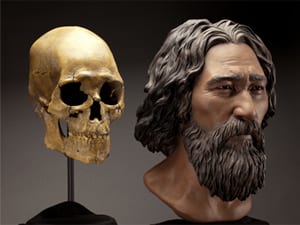
Writing for London-based the Daily Mail, the world’s largest online news source, science news journalist Ellie Zolfagharifard covered the research of SMU paleontologist Louis L. Jacobs, a professor in the Roy M. Huffington Department of Earth Sciences, Dedman College of Humanities and Sciences, and paleontologist Anthony Fiorillo, vice president of research and collections and chief curator at the Perot Museum of Nature and Science, Dallas, and an adjunct research professor at SMU.
Jacobs and Fiorillo are co-authors of a study about the identification of new fossils from the oddball creature Desmostylia, discovered in the same waters where the popular “Deadliest Catch” TV show is filmed. The hippo-like creature ate like a vacuum cleaner and is a new genus and species of the only order of marine mammals ever to go extinct — surviving a mere 23 million years.
Desmostylians, every single species combined, lived in an interval between 33 million and 10 million years ago. Its strange columnar teeth and odd style of eating don’t occur in any other animal, Jacobs said. The new specimens — from at least four individuals — were recovered from Unalaska, an Aleutian island in the North Pacific.
The authors reported their discovery in a special volume of the international paleobiology journal, Historical Biology. The article published online Oct.1 at http://bit.ly/1PQAHZJ.
The Daily Mail article published Oct. 8, 2015.
EXCERPT:
By Ellie Zolfagharifard
Daily Mail
A bizarre hippo-like creature, that lived 23 million years ago, had a long snout that allowed it to suck up food like a vacuum cleaner.This is according several fossils of the species which were discovered on the island of Unalaska in the North Pacific.
They reveal a unique tooth and jaw structure for the creature, which scientists believe belonged to a group of aquatic mammals called Desmostylia.
Desmostylians lived between 33 million and 10 million years ago. But unlike other marine mammals alive today, they went completely extinct.
Researchers have named the vegetarian species Ounalashkastylus tomidai, and describe it as having strange columnar teeth that allowed it to vacuum food.
While alive, the creatures lived in what is now Unalaska’s Dutch Harbor, where fishing boats depart on Discovery channel’s ‘Deadliest Catch’ reality TV show.
‘The new animal — when compared to one of a different species from Japan — made us realise that desmos do not chew like any other animal,’ said Professor Louis Jacobs at the Southern Methodist University in Texas.
‘They clench their teeth, root up plants and suck them in.’
To eat, the animals buttressed their lower jaw with their teeth against the upper jaw, and used the powerful muscles that attached there.
Combined with the shape of the roof of their mouth, this allowed them to suction-feed vegetation from coastal bottoms.
Follow SMUResearch.com on twitter at @smuresearch.
SMU is a nationally ranked private university in Dallas founded 100 years ago. Today, SMU enrolls nearly 11,000 students who benefit from the academic opportunities and international reach of seven degree-granting schools. For more information see www.smu.edu.
SMU has an uplink facility located on campus for live TV, radio, or online interviews. To speak with an SMU expert or book an SMU guest in the studio, call SMU News & Communications at 214-768-7650.


 $3.78 million awarded by Department of Defense to SMU STEM project for minority students
$3.78 million awarded by Department of Defense to SMU STEM project for minority students Kennewick Man: genome sequence of 8,500-year-old skeleton solves scientific controversy
Kennewick Man: genome sequence of 8,500-year-old skeleton solves scientific controversy At peak fertility, women who desire to maintain body attractiveness report they eat less
At peak fertility, women who desire to maintain body attractiveness report they eat less